Spring onions also referred to as Allium fistulosum is a perennial plant. It is very delicious and versatile. They can be grown in minimal space and require little effort.
The bulbs of spring onions can be consumed along with the greens. The whole plant holds importance and can be consumed either raw or cooked.
Names and varieties of spring onions vary a lot. A few varieties of spring onions are- shallots (Australia), shallots, salad onions, Japanese welchbunching onions, scallions in the US, green onions (China), and Egyptian or tree onions. Some varieties have very small bulbs and some don’t have bulbs at all.
Bulbs of spring onions can be consumed raw because they do not have much intense flavor. It can be grown from seed or bulb and can be stored easily for later use.
The main variety of spring onion (Allium fistulosum) has no bulb in it. Allium refers to garlic and fistuosum means hollow stemmed in Latin.
Spring onions are plants with a bulb and hollow stem covered with edible mild flavoured leaves.
One variety of spring onions called red-stemmed spring onion is ornamental and eatable.
Flavour- these plants are mild flavoured. The bulb can be consumed along with leaves. Flavours of spring onions vary with variety from strong to sweet and mild.
These perennial vegetables can be grown easily with very little effort and in minimal space. They are generally grown in subtropical regions. However, in cooler areas, such vegetables can be grown in nurseries. They can easily grow well in containers and even in the water on the kitchen bench.
Height- The height of these plants ranges between 35-50 cm (12-20inch) singly or in clusters. The height of plants generally depends upon their variety. The root system of spring onions is very shallow. Therefore they can be easily grown in small pots.
Growth of spring onions
Safe organic certified seeds can be used to grow healthy spring onions.
Plants can also be grown from seeds saved from previous crops.
Here is the way to collect seeds from spring onion plants-
First, wait till the flower head of the spring onion matures fully. They chop that flower off and store it in place to dry it off. Place it to dry for around 2 weeks. Shake the seeds and scoop them out after they are completely dried. Store them in cool and dry places and seal them completely so that they do not get in contact with moisture and germinate.
Spring onions can be stored for at least 2 years in dry places. As the age of seeds increases so does the time for germination of seeds. Germination of seeds is fastest when they are fresh.
To grow healthy plants, you need to provide them with proper nutrition too. Homemade seed raising mix can save loads of money and is organic at the same time.
While growing spring onions keep them moist and do not let them dry. if seeds dry out, this can lead to death. Plus, you can cover them to maintain humidity.
You can also transplant them when they reach a height of around 15 cm. Buy 15 cm seedlings and plant them in your home garden.
Choose varieties that suit the climate of your region. If you belong to colder regions then use the hardiest spring onion that is red welsh. Benizone variety also grows well in cold areas and has violet coloured stalks.
Commonly preferred varieties of spring onions are mentioned below-
Spring onion ‘white Lisbon’–
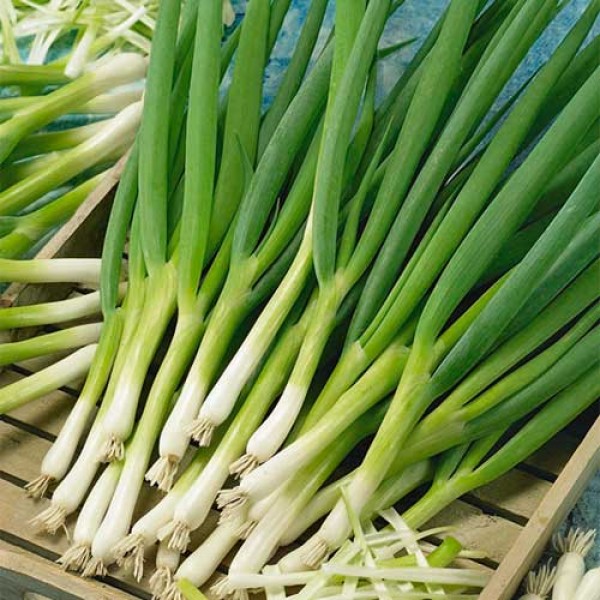
They have a short cropping time and are great for overwintering. Due to their easy growth, they are a perfect choice for new and inexperienced gardeners.
Spring onion ‘Pompeii’-
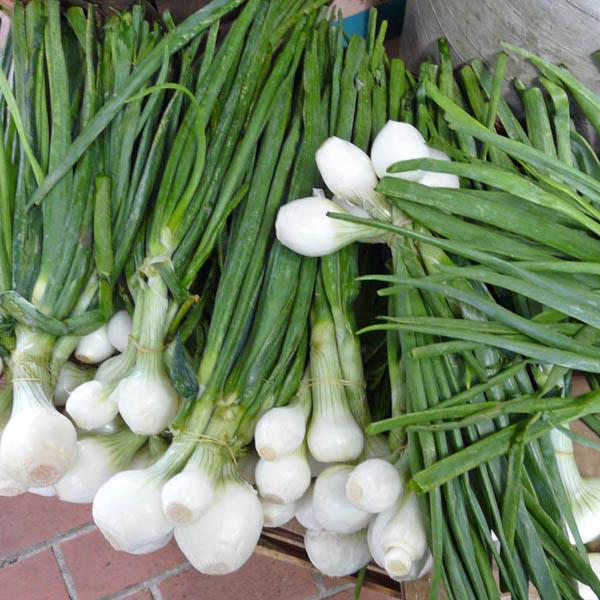
The bulbs of this variety are rounder in shape and silver-skinned. They are best for picking ad serving on cocktail sticks
Spring onion ‘apache’-
This red variety has a very good flavor as compared to others. It has a crisp flavor and adds color to salads.
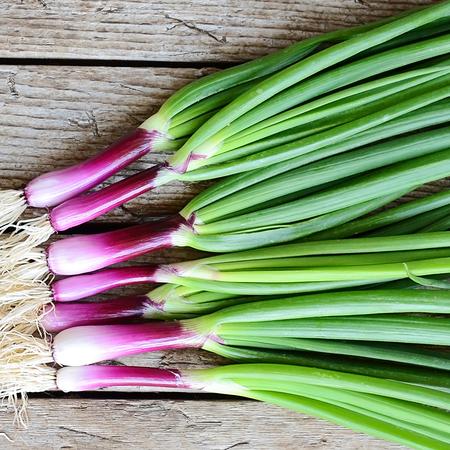
Spring onions feast F1 hybrid- this one is outstanding and all-rounder. Successive sowings to harvest all summer long.
Spring onions should be planted every 3-4 weeks to ensure a regular supply of spring onions.
Must Read: Onion Farming, Planting, Care, Harvesting
Sowing seeds
Soil for sowing seeds must be fertile and well-drained. Prepare the soil beforehand of sowing seeds in it. Use fertilizers or manure to make it fully nutritious.
Sow seeds of spring onions in 5mm ( ⅕ inch) deep holes. Place them at least 5mm apart and in 15 cm apart rows. They need around 8-12 weeks to mature. They do not require to be thinned because you will pull them when they mature and use them straight.
Soil is used for planting spring onions must be well-drained. Spring onions hate loamy or too wet soil. They can rot or even die with excess amounts of water. Therefore, choose well-drained soil and it should be loose and friable.
You can also add compost or manure to make it nutritious for plants. Worm castings and liquid fertilizers are also preferred by people.
the pH of the soil must be around 6-7. If it is too acidic then add sulfur to make it normal and if the soil is too basic then add lime to make it usable.
Placement of plants for proper growth should be in well-lit areas. The sunny position ensures good and fast growth in spring onions. Ensure regular watering for proper growth.
For greener leaves of spring onions, you can use liquid seaweed, a weak worm juice, or compost tea.
Due to the shallow root system, spring onions can be easily grown in small pots or containers.
Avoid planting spring onions near peas or beans. Also, drying out or stress is completely disliked by these flavored perennials. Competition from weeds can lead to weak plants because of a lack of nutrition. Further, keep them full at all times. Hungry plants will become weak and non-delicious.
Tip- you do not seed for growing spring onions. You can grow spring onions from bought spring too. Here is how-
Cut them from around 1 inch above the bulb. Now you can use the above portion of leaves in cooking. The leftover should be placed in a container filled with water. Dip the bulb in water and place it in sunlight or near your window. Do change the water every day. After 2 days you will observe stem growing. You can cut the tops again and leave it growing more.
How long does it take for spring onion seeds to germinate?
So further you might be wondering, once you sow the seeds; when will the seeds germinate?
It takes around 2 weeks for seeds of spring onions to germinate. Germination slows at lower temperatures like 6-7C. However, if the temperature is raised then germination speeds up. The optimum temperature for germination is 10-35C. Therefore, it is evident that this crop germinates fast in warmer conditions. They can even germinate in as little as 4 days if temperature conditions are favourable.
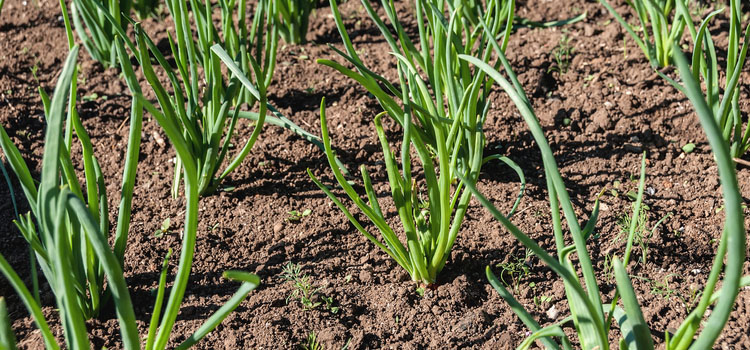
Artificial practices like the usage of bottom heat can help raise temperatures and speed up the germination process.
Once they grow up to a height of 8-10 inches you can transplant them into your home garden in case you sowed them in a container.
When to harvest spring onions?
Spring onions are ready to harvest when they reach a height of 12-20 inches. They mature in around 8-12 weeks. If you wish to harvest strongly flavored spring onions, then let them mature over 8 weeks. Mildly flavoured spring onions can be harvested early.
Spring onions can be used as a filler crop too. Grow them in between other slower growing vegetables to keep your soil healthy and working.
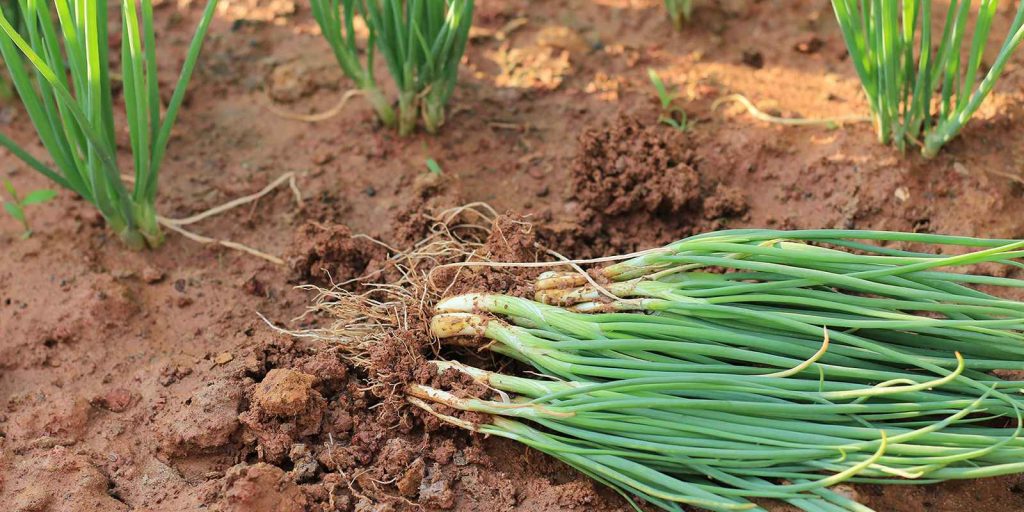
Once they are tall, green, and healthy-looking, they are ready to harvest. You can even cut greens with a scissor at least 3 cm above ground level. Then leave bulbs in the soil to grow more. you can water the plant with seaweed for faster regrowth. Snipping of outer leaves encourages more growth in plants. Depending on varieties, some spring onions are white while some develop brown bulbs.
In colder temperatures, you can grow spring onions in water inside your house to maintain temperatures.
Storage
Use flowers on spring onions to obtain seeds and save them for further use.
After harvesting spring onions, wrap them in plastic. Edible flowers of some varieties can be harvested for use in salads, stir-fries, or for garnishing purposes.
Health benefits of spring onions
Spring onions are full of health benefits. The presence of various nutrients makes them very healthy. Along with nutrients, the taste of this vegetable is also very good.
They help in lowering cholesterol. They also have antibacterial and antifungal properties. Spring onions also benefit people by relieving sinus and chest ailments.
Asthma and bronchitis ailments can also be treated by the consumption of spring onions regularly. Further, spring onions also contain anticoagulants. This helps in the thinning of blood and lowers the risk of a heart attack.
The presence of high sulfur content in spring onions purifies blood, makes skin clearer, cleanses the liver, and improves immunity.
Few recipes of spring onions
As already known spring onions are loaded with deliciousness and their versatile nature makes them readily useful. They can be used to make stir-fries, used in salads, making dips, chutneys, salsa, omelets, and even used as garnishing.
Spring onions taste so delicious when raw and even when cooked.
Mature bulbs are strong flavoured and young slender leaves are mildly flavoured and can be enjoyed in various recipes. They are most nutritious when raw.
You can even put them in rice, noodles, soups, pasta, eggs, or casserole to enhance the flavour and make your dishes even more delicious.
Pest and diseases
Thrips are the main organisms that affect spring onions. They are small sucking insects and are active in warmer months. Dry and warm conditions are favorable for the growth of such insects.
To avoid problems, keep a check on the center of plants regularly. Keeping them moist will keep most of the problems away. Tiny thrips usually attach themselves to new leaves. They cause the appearance of white, silver, and grey blotches on leaves.
Downy mildew
This disease results in white to purple furry growth on the surface of older leaves. Leaf tissue becomes pale then yellow and collapses eventually. This disease is spread by wind. It is the main disease that occurs in spring onions and shallot production.
Alternate fungicides can be used to cure the disease.
Grey mould
Cool, moist springs result in the spread of this disease. Symptoms in this disease are rotting of the bulb and sunken lesions on the side or base of the bulb. Fungicides can be used to treat this disease.
White rot (Sclerotium cepivorum)
Yellowing, wilting, and death of leaves are observed in infected plants. Decaying of leaves begins at the base and older leaves are affected at first. Fluffy mycelial growth is observed on the bulb.
The severity of this disease varies with regions. Regions like SA and VIC are majorly hit by this disease.
Fungicides are not being used yet to treat this disease. However, soil can be gotten rid of the fungus. Plus, Trichoderma can be used as a biological treatment.
Further, carrot flies are also harmful to spring onions. You can keep carrot flies away by growing them between carrot plants.
Use horticultural fleece to protect them from birds.
Conclusion
Spring onions or shallots are so easy to grow and maintain. They do not require much space or effort of yours. Growing these perennial plants is interesting and fruitful.
Whole spring onions can be consumed except roots. The white bulb is strongly flavoured and tender in texture while the green part is crispier and has a mild flavour.
With amazing health benefits and delicious taste, these vegetables are a must-have for your garden.

